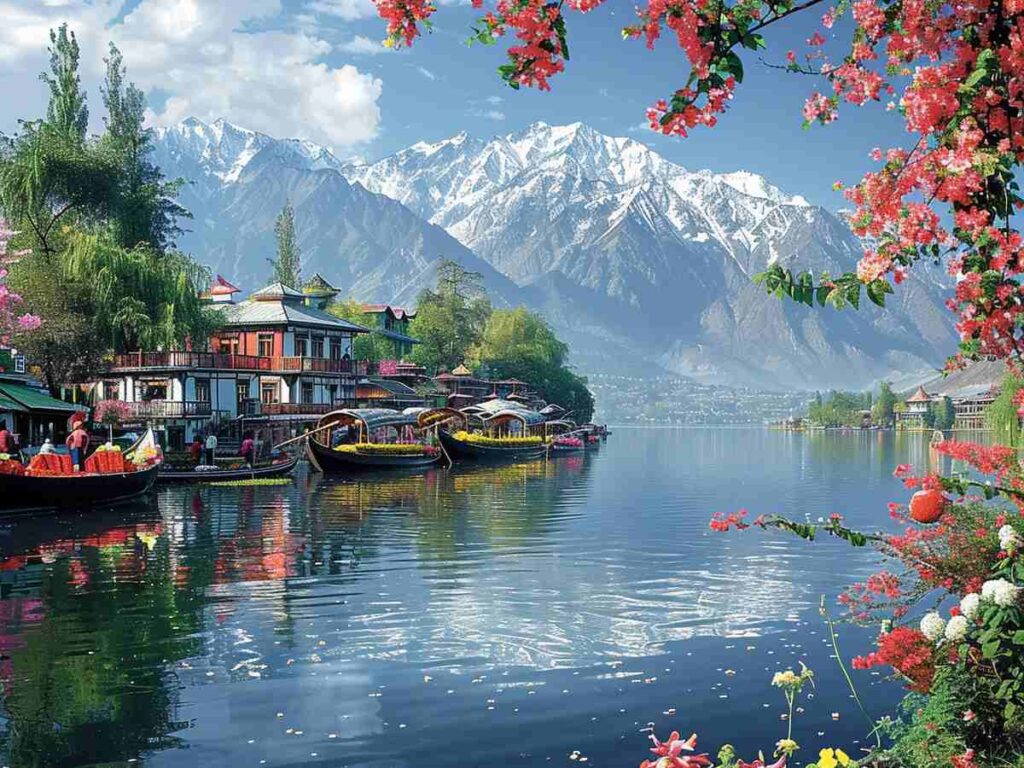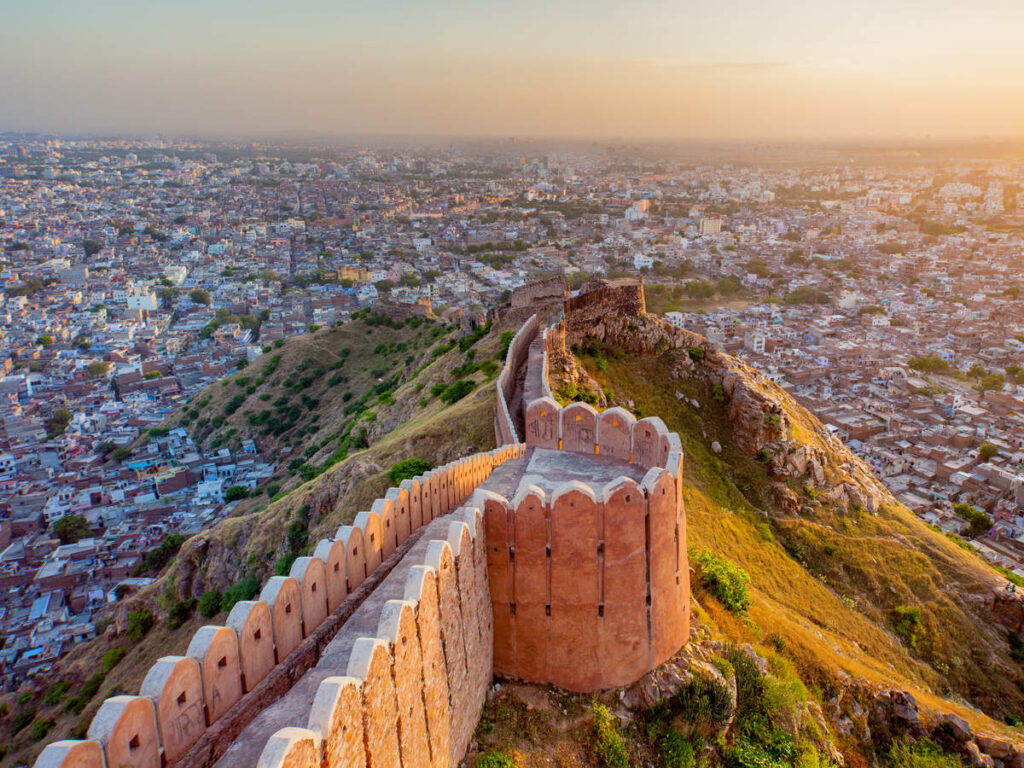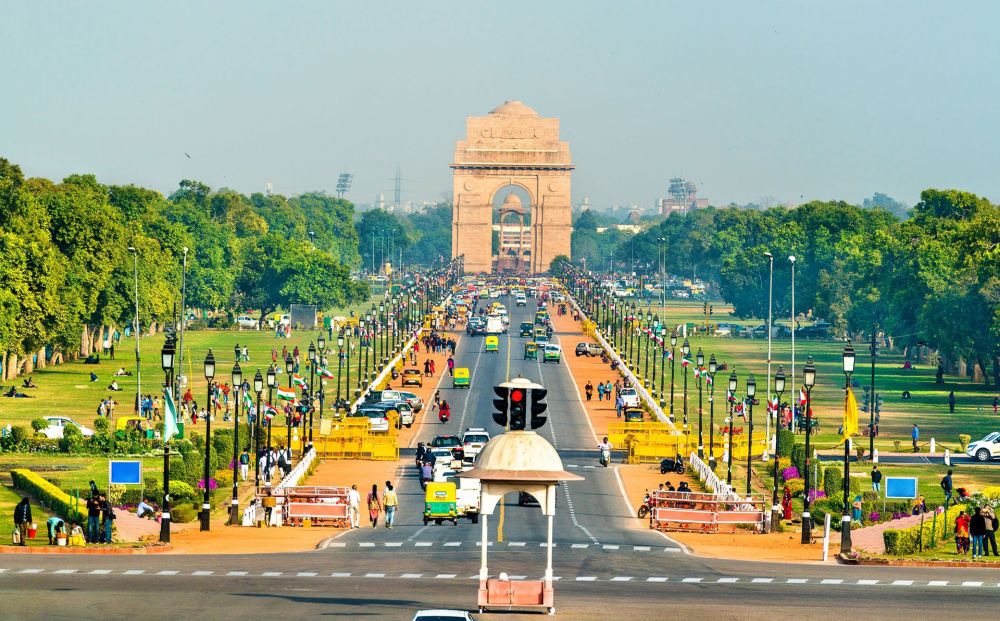KASHMIR :THE HEART OF INDIA

KASHMIR: THE HEART OF INDIA Kashmir Tourist Guide: Unveiling the Paradise of India Kashmir, often referred to as “Paradise on Earth,” is a place of breathtaking landscapes, vibrant culture, and captivating history. Located in northern India, this region is known for its snow-capped mountains, crystal-clear lakes, lush valleys, and traditional charm. Whether you’re an adventure seeker, nature lover, or history enthusiast, Kashmir offers an unforgettable experience. This guide will help you plan your trip and make the most of what Kashmir has to offer. 1. Best Time to Visit Kashmir • Spring (March to May): Witness blooming flowers in gardens like the famous Shalimar Bagh and Nishat Bagh. The pleasant weather makes it an ideal time for sightseeing. • Summer (June to August): With temperatures ranging from 15°C to 30°C, it’s a great time to explore the scenic valleys and enjoy outdoor activities. • Autumn (September to November): Known as the “golden season” in Kashmir, autumn brings a unique charm as the landscape is painted in warm hues. • Winter (December to February): Ideal for snow lovers and winter sports enthusiasts, this is the time to experience snowfall and try skiing in Gulmarg. 2. Top Tourist Destinations • Dal Lake: Famous for its floating gardens and houseboats, Dal Lake offers a unique experience with shikara rides. • Mughal Gardens: Discover beautiful gardens like Shalimar Bagh, Nishat Bagh, and Chashme Shahi, showcasing Persian-inspired designs. • Hazratbal Shrine: A serene and sacred spot by Dal Lake with stunning views and historical significance. • Gulmarg Gondola: One of the highest cable cars in the world, offering panoramic views of the snow-capped Himalayas. • Skiing and Snowboarding: A winter paradise for adventure seekers, with several ski resorts offering rentals and lessons. • Golf Course: In the summer, try golfing at one of the world’s highest golf courses. • Betaab Valley: Named after the Bollywood film “Betaab,” it’s a lush valley with breathtaking views, perfect for picnics and photography. • Aru Valley: Known for scenic treks, camping, and horse riding, Aru Valley is a serene escape into nature. • Lidder River: A popular spot for white-water rafting and fishing. • Thajiwas Glacier: Accessible by pony rides or trekking, the glacier is a stunning sight, especially during the summer. • Zoji La Pass: This high mountain pass connects Kashmir to Ladakh and offers dramatic landscapes. • Camping and Trekking: Sonmarg is the gateway to several trekking routes, including the famous Kashmir Great Lakes trek. 3. Adventure Activities • Trekking: Kashmir is a trekker’s paradise, with routes like the Amarnath Yatra trek, Great Lakes Trek, and Tarsar Marsar trek. • Rafting: The Lidder and Sindh rivers offer thrilling rapids suitable for adventure lovers. • Paragliding: Experience paragliding over Pahalgam’s beautiful landscapes for an exhilarating view. • Fishing and Angling: Kashmir’s rivers are rich in trout, and fishing here can be a peaceful, unique experience. 4. Local Cuisine to Try Kashmiri cuisine is rich and flavorful, influenced by its geography and culture. Some must-try dishes include: • Rogan Josh: A flavorful lamb curry cooked with aromatic spices. • Kahwa: A traditional green tea with saffron, almonds, and spices. • Dum Aloo: Spiced potatoes cooked with curd and spices. • Wazwan: A royal feast comprising a variety of dishes, often served during celebrations. 5. Shopping in Kashmir • Pashmina Shawls: Renowned worldwide, these shawls are made from fine wool and often intricately embroidered. • Saffron: Known as the “Golden Spice,” Kashmiri saffron is a prized souvenir. • Walnut Wood Carvings: Beautifully crafted furniture, boxes, and other artifacts. • Paper-Mâché: Vibrantly painted items, including jewelry boxes and decorations. • Dry Fruits and Spices: Stock up on high-quality almonds, walnuts, and Kashmiri spices like saffron and shahi jeera. 6. Travel Tips • Permits: Some regions require special permits, particularly close to the border, so check in advance. • Clothing: Dress in layers, as temperatures can vary. Warm clothes are essential in winter, even in summer in high-altitude areas. • Local Etiquette: Respect the local culture and customs. Always ask before taking photos of people, especially in religious areas. • Safety: Although tourism is encouraged, stay informed about local advisories or restrictions. Kashmir’s natural beauty, warm hospitality, and unique charm make it a must-visit destination for travelers. With this guide, you’ll be well-prepared to explore, enjoy, and make lasting memories in this breathtaking region.
JAIPUR: THE PINK CITY

TOURISM GUIDE FOR JAIPUR The Ultimate Jaipur Tourist Guide: Discover the Pink City Welcome to Jaipur, a city that blends vibrant culture, grand palaces, and an endless array of history. Known as the Pink City due to its stunningly warm-hued architecture, Jaipur offers a rich experience for travelers. Here’s a guide to exploring Jaipur, with a mix of must-see landmarks, local tips, and recommendations for food and shopping. 1. Best Time to Visit Jaipur • October to March: The best months, as the weather is cooler, making sightseeing more enjoyable. • July to September: The monsoon season brings occasional showers, turning the landscape lush and green. • April to June: Summer can be harsh, with temperatures rising above 40°C, so plan indoor activities if you visit during this time. 2. Top Places to See a) Amber Fort • This majestic fort atop the Aravalli hills is known for its Hindu-Muslim architecture, mirror work, and historic charm. Don’t miss the Sheesh Mahal (Mirror Palace) and the light and sound show at night. • Tip: Arrive early to avoid crowds and the midday heat. b) City Palace • The royal residence of the Jaipur Maharaja, this palace features a museum with historical artifacts, weapons, and textiles. You can also catch the beautiful blend of Rajasthani and Mughal architecture. • Tip: Book a guided tour for insight into the palace’s history. c) Hawa Mahal (Palace of Winds) • Famous for its honeycomb structure, this pink sandstone building was made for royal women to observe city life from behind its latticed windows. • Tip: Visit early morning for the best lighting and fewer crowds. d) Jantar Mantar • A UNESCO World Heritage Site, Jantar Mantar is an 18th-century observatory with a collection of astronomical instruments. • Tip: A guide can help you understand the scientific significance of each structure. e) Nahargarh Fort • Offering stunning sunset views, this fort overlooks Jaipur and is perfect for a relaxing evening with a view of the city’s lights. • Tip: The onsite restaurant Padao serves snacks and drinks, making it a great sunset spot. f) Jal Mahal (Water Palace) • Located in the middle of Man Sagar Lake, Jal Mahal is a serene sight, especially in the evening when the palace is illuminated. • Tip: You can’t enter the palace, but boat rides are available, giving you a closer look. 3. Unique Experiences • Hot Air Balloon Ride: Catch breathtaking aerial views of Jaipur’s forts and landscapes. • Elephant Village Tour: Spend time with elephants at Elefantastic, an ethical farm that focuses on the wellbeing of these gentle giants. • Cooking Class with Locals: Learn to make authentic Rajasthani dishes with local families, an experience that brings you closer to Jaipur’s culture. 4. Where to Stay • Luxury: Rambagh Palace offers a royal stay with luxurious amenities and impeccable service. • Mid-Range: Samode Haveli provides a boutique heritage experience with beautiful decor and excellent hospitality. • Budget: Zostel Jaipur is a great option for backpackers, with clean rooms, social activities, and a central location. 5. Food to Try • Dal Baati Churma: A traditional Rajasthani dish of baked dough balls with lentils and sweetened crushed wheat. • Laal Maas: A spicy meat curry cooked with red chilies, perfect for those who love bold flavors. • Kachori: Try the famous Pyaaz Kachori (onion-filled pastry) and Mawa Kachori (sweet). • Ghevar: A popular sweet, especially during the Teej festival. Tip: For authentic local food, try Laxmi Mishthan Bhandar (LMB) or Rawat Mishthan Bhandar. 6. Shopping Spots • Johari Bazaar: Known for jewelry, especially traditional Rajasthani designs and gemstones. • Bapu Bazaar: Best for textiles, handicrafts, and leather items. Look out for Mojari shoes, Jaipur’s signature footwear. • Tripolia Bazaar: Famous for lac jewelry and bangles, ideal for finding colorful accessories. • MI Road: Great for branded stores, antique shops, and Jaipur’s famous blue pottery. Tip: Bargaining is common in local markets, so don’t hesitate to negotiate. 7. Travel Tips • Local Transport: Autos and cycle rickshaws are the main modes of transport. Alternatively, use ride-sharing apps like Uber and Ola. • Dress Comfortably: Jaipur can be warm, so wear light fabrics and comfortable shoes, especially if you’re exploring the forts. • Stay Hydrated: Carry a water bottle, as you’ll be doing a lot of walking. • Respect the Culture: When visiting religious sites, dress modestly and be mindful of local customs. Whether you’re drawn to Jaipur for its majestic forts, unique shopping experiences, or vibrant culinary scene, the Pink City has something to offer every traveler. With this guide, you’re set to explore Jaipur like a pro. Happy travels!
DELHI TORIST GUIDE

TOURISM IN DELHI: EXPLORE THE HEART OF INDIA Delhi, the capital city of India, is a vibrant blend of history, culture, and modernity. From majestic Mughal architecture to bustling markets and modern skyscrapers, Delhi offers a wide array of experiences for every traveler. Here’s a guide to help you navigate through the key attractions and experiences: 1. Historical Landmarks • Red Fort (Lal Qila): A UNESCO World Heritage Site, this red sandstone fortress was the main residence of Mughal emperors. The fort offers a glimpse into the grandeur of Mughal architecture. • Qutub Minar: Another UNESCO World Heritage Site, this 73-meter high tower was built in the 12th century. It is surrounded by several ancient structures and the famous Iron Pillar. • Humayun’s Tomb: A precursor to the Taj Mahal, this stunning garden tomb of the Mughal Emperor Humayun is an architectural masterpiece. • India Gate: A war memorial built in honor of Indian soldiers who died during World War I, it’s a popular spot for evening strolls and picnics. • Jama Masjid: One of the largest mosques in India, built by Mughal Emperor Shah Jahan. Its grand architecture and beautiful courtyard make it a must-visit. 2. Cultural and Spiritual Sites • Lotus Temple: Known for its distinctive flower-like shape, this Bahá’í House of Worship is a serene place for reflection and meditation. • Akshardham Temple: A sprawling Hindu temple complex, known for its intricate carvings and beautiful gardens. It also hosts a cultural exhibition and musical fountain show. • Gurudwara Bangla Sahib: A prominent Sikh gurdwara, it’s known for its golden dome and large pond. It offers a peaceful atmosphere and free community meals (langar) for visitors. • Laxminarayan Temple (Birla Mandir): A large Hindu temple dedicated to Lord Vishnu and Goddess Laxmi, it is a significant spiritual and architectural landmark . 3. Museums and Art Galleries • National Museum: A treasure trove of Indian history, culture, and art, the National Museum displays artifacts ranging from the Indus Valley Civilization to modern times. • National Gallery of Modern Art (NGMA): This gallery showcases a vast collection of modern Indian art, with works by famous Indian artists like Raja Ravi Varma and Amrita Sher-Gil. • Gandhi Smriti: This museum is dedicated to Mahatma Gandhi and is the site where he spent his last days. The exhibits focus on his life and philosophy. 4. Local Markets and Shopping • Chandni Chowk: One of Delhi’s oldest and busiest markets, Chandni Chowk is a chaotic yet fascinating experience. From spices and jewelry to street food and traditional clothes, you’ll find everything here. • Connaught Place: A circular shopping and business hub, Connaught Place (CP) offers everything from high-end brands to street shopping and numerous cafes and restaurants. • Dilli Haat: A vibrant open-air market featuring handicrafts, textiles, and cuisine from across India. It’s the perfect spot to buy traditional souvenirs and try regional dishes. • Sarojini Nagar: A famous market for trendy, affordable clothing and accessories. Bargaining is a must here! 5. Modern Attractions and Experiences • Kingdom of Dreams: A live entertainment venue in Gurgaon (just outside Delhi), offering Bollywood-style musicals and cultural shows, along with themed restaurants showcasing Indian cuisine. • Hauz Khas Village: A trendy area combining a historic reservoir with chic cafes, art galleries, and boutiques. It’s a great place to experience Delhi’s vibrant art and nightlife scenes. • Delhi Street Food Tour: Delhi is known for its street food, especially in places like Chandni Chowk and Karol Bagh. Don’t miss out on local favorites like chole bhature, golgappas, parathas, and kebabs. 6. Parks and Nature • Lodhi Gardens: A beautiful park dotted with tombs from the Lodi dynasty, perfect for a relaxing walk or picnic amidst historical ruins. • Garden of Five Senses: A landscaped park offering a blend of nature and art, designed to stimulate all five senses with its beautiful flowers, water fountains, and sculptures. • Raj Ghat: The memorial to Mahatma Gandhi, this peaceful park area is where he was cremated. It is surrounded by beautiful gardens. 7. Best Time to Visit • October to March: The weather is pleasant, making it the best time to explore the city. Winters (December to January) can get chilly, so carry warm clothes. • April to June: Summers can be scorching with temperatures soaring above 40°C. • July to September: Monsoon season brings occasional rains, making the weather humid but cooler. 8. Getting Around Delhi • Delhi Metro: The metro system is one of the easiest and most efficient ways to get around the city. It connects all major tourist spots. • Auto Rickshaws and Taxis: Widely available, but it’s best to negotiate fares or use ride-hailing apps like Uber and Ola. • Buses: Delhi has an extensive bus network, but it can be crowded and difficult to navigate for tourists. 9. Safety Tips • Keep your belongings secure, especially in crowded areas. • Be cautious of scams and touts around tourist attractions. • Use official tour guides or authorized services for a better experience. 10. Must-try Delhi Foods • Paranthas: Especially in the famous Paranthe Wali Gali in Chandni Chowk. • Chole Bhature: A spicy chickpea curry served with fried bread. • Kebabs: Delhi is famous for its Mughlai cuisine, with an array of kebabs. • Jalebi and Rabri: Sweet treats you’ll find in most markets. Delhi’s diverse culture, rich history, and modern attractions make it a city like no other. From exploring ancient forts to indulging in street food, Delhi offers an unforgettable journey into the heart of India.